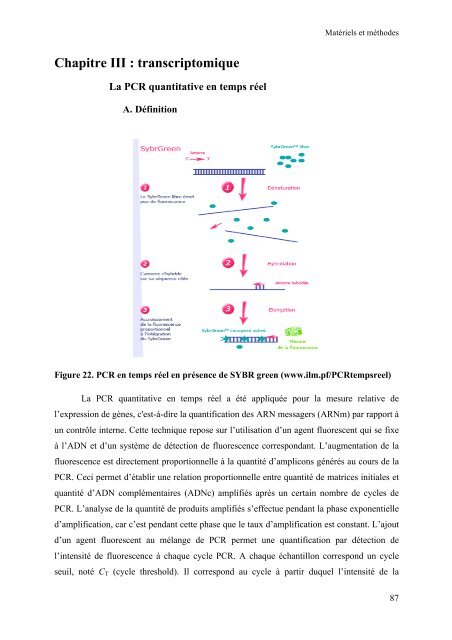THESE Maryse Bonnin Jusserand - Université de Bourgogne
THESE Maryse Bonnin Jusserand - Université de Bourgogne
THESE Maryse Bonnin Jusserand - Université de Bourgogne
Create successful ePaper yourself
Turn your PDF publications into a flip-book with our unique Google optimized e-Paper software.
Chapitre III : transcriptomique<br />
La PCR quantitative en temps réel<br />
A. Définition<br />
Matériels et métho<strong>de</strong>s<br />
Figure 22. PCR en temps réel en présence <strong>de</strong> SYBR green (www.ilm.pf/PCRtempsreel)<br />
La PCR quantitative en temps réel a été appliquée pour la mesure relative <strong>de</strong><br />
l’expression <strong>de</strong> gènes, c'est-à-dire la quantification <strong>de</strong>s ARN messagers (ARNm) par rapport à<br />
un contrôle interne. Cette technique repose sur l’utilisation d’un agent fluorescent qui se fixe<br />
à l’ADN et d’un système <strong>de</strong> détection <strong>de</strong> fluorescence correspondant. L’augmentation <strong>de</strong> la<br />
fluorescence est directement proportionnelle à la quantité d’amplicons générés au cours <strong>de</strong> la<br />
PCR. Ceci permet d’établir une relation proportionnelle entre quantité <strong>de</strong> matrices initiales et<br />
quantité d’ADN complémentaires (ADNc) amplifiés après un certain nombre <strong>de</strong> cycles <strong>de</strong><br />
PCR. L’analyse <strong>de</strong> la quantité <strong>de</strong> produits amplifiés s’effectue pendant la phase exponentielle<br />
d’amplification, car c’est pendant cette phase que le taux d’amplification est constant. L’ajout<br />
d’un agent fluorescent au mélange <strong>de</strong> PCR permet une quantification par détection <strong>de</strong><br />
l’intensité <strong>de</strong> fluorescence à chaque cycle PCR. A chaque échantillon correspond un cycle<br />
seuil, noté CT (cycle threshold). Il correspond au cycle à partir duquel l’intensité <strong>de</strong> la<br />
87

















